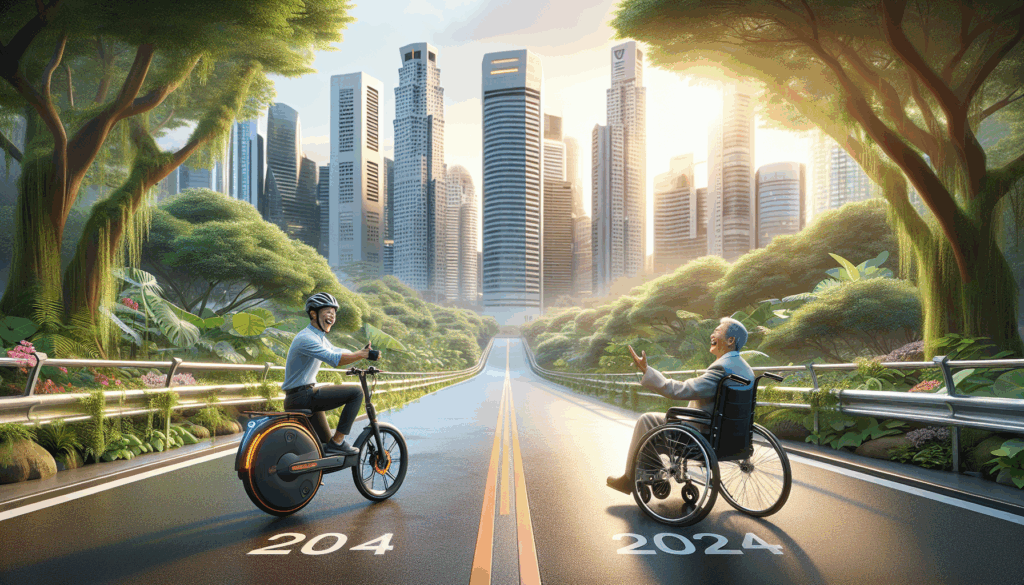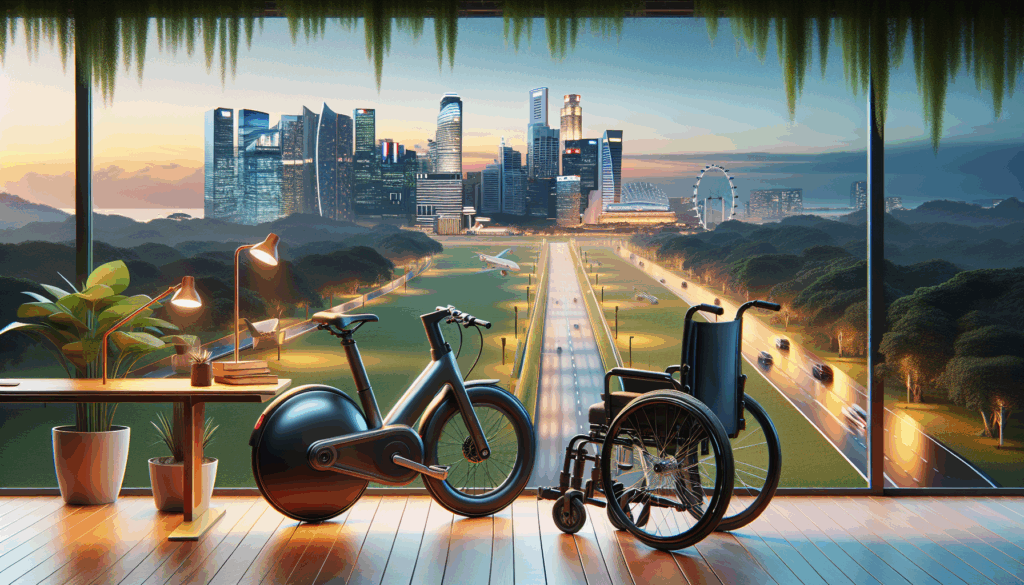Table of Contents
Amidst this growth, it’s essential to differentiate between PMDs and power-assisted bicycles (PABs), which are also subject to regulations by the Land Transport Authority (LTA). Moreover, In recent years, the rise of personal mobility devices such as escooters has gained significant attention in Singapore.
While both modes of transportation offer convenience and ease of use, there are distinct differences between them, particularly in terms of design, utility, pricing, and usage spaces. In this blog post, we will delve into the comparisons and contrasts between PABs and PMDs, as well as their categorisation and regulations in Singapore.

What are PABs and PMDs?
Personal mobility devices and power-assisted bicycles are popular modes of transport in Singapore, offering convenient and eco-friendly alternatives to traditional vehicles. A PAB, commonly referred to as an ebike, features a pedal-assist system that amplifies a rider’s pedaling effort using an electric motor. This makes it a practical choice for commuting longer distances or navigating hilly terrain with minimal physical effort.
PMDs, on the other hand, encompass devices like escooters and hoverboards, which rely entirely on motorized propulsion. These devices are ideal for shorter trips and navigating urban areas where compactness and maneuverability are key. Both power-assisted bicycles and personal mobility devices align with Singapore’s push for sustainable transport options, but they cater to different commuting needs and adhere to distinct regulations set by the Land Transport Authority (LTA).
Design Differences: Pedal Assist vs Throttling System
The primary design difference between power-assisted bicycles and personal mobility devices lies in their propulsion mechanisms. Power-assisted bicycles operate using a pedal-assist system, where the electric motor activates as the rider pedals. This system not only reduces physical effort but also offers a seamless riding experience, closely mimicking traditional cycling. Riders can control the level of assistance, making it suitable for different fitness levels and terrains.
PMDs, such as escooters, use a throttling system, which allows the user to control speed with a hand lever or button, requiring no pedaling effort. This makes personal mobility devices particularly convenient for those who prioritize ease of use over exercise. However, the absence of pedaling means personal mobility devices are generally less versatile for long distances or uphill travel. Understanding these design differences is crucial for choosing the device that best suits your lifestyle and commuting requirements.
Utility Differences: Distance, Battery Options, and Portability
PABs and PMDs differ significantly in utility, particularly in terms of distance, battery options, and portability. Power-assisted bicycles typically boast larger battery capacities, enabling them to cover longer distances, often exceeding 70 km on a single charge. This makes them ideal for extended commutes or recreational rides. PMDs, with smaller battery capacities, are better suited for shorter trips, usually ranging from 20 to 40 km per charge.
In terms of portability, personal mobility devices often have a compact and lightweight design, making them easy to carry and store in small spaces. Power-assisted bicycles, with their larger frames and components, are less portable but offer greater stability and comfort during rides. Battery options also differ; Power-assisted bicycles generally come with removable batteries, allowing for convenient charging and potential upgrades, whereas PMDs typically have built-in batteries.
Price Comparison: PABs vs PMDs
When it comes to pricing, Power-assisted bicycles generally cost more than PMDs due to their complex systems and robust construction. A quality power-assisted bicycle in Singapore may range from $1,000 to $3,000, depending on features like battery capacity, motor power, and additional components such as racks or lights. In contrast, personal mobility devices, particularly e-scooters, typically fall within a range of $300 to $1,500.
While the upfront cost of a power-assisted bicycle may be higher, its longevity and lower running costs—thanks to efficient battery use and minimal wear-and-tear—can make it more economical over time. personal mobility devices, being lighter and less complex, have a lower initial investment but may require more frequent maintenance due to their smaller size and integrated components. Budget considerations should align with the intended usage and frequency of travel.
Regulations in Singapore: LTA’s Guidelines for Ebike and Escooter
The Land Transport Authority (LTA) in Singapore imposes stringent regulations to ensure the safe use of Ebikes and Escooters. Ebikes must comply with the EN15194 standard, weigh no more than 20 kg, and be registered with an orange number plate. Riders must also be at least 16 years old and wear helmets when riding on roads.
For personal mobility devices, only e-scooters meeting UL2272 fire safety standards are allowed, and they must not exceed 20 kg or a top speed of 25 km/h. Escooters are restricted to cycling paths and park connectors, with riding on roads strictly prohibited. Adherence to these regulations is essential for ensuring safety and avoiding penalties.
Utilisation Space: Where to Ride Ebikes and Escooters in Singapore
In Singapore, ebikes and escooters have designated spaces for operation to ensure pedestrian and rider safety. Ebikes are permitted on cycling paths, shared paths, and roads, making them a versatile choice for urban and suburban commuting. Their ability to travel on roads provides flexibility for riders covering longer distances.
Escooters, however, are restricted to cycling paths and park connectors. This limitation enhances safety in shared spaces but may reduce their practicality for commuting in areas with limited path connectivity. Riders must familiarize themselves with these utilisation rules to avoid penalties and ensure a smooth riding experience.
Comparison Chart: PABs vs PMDs in Singapore
| Feature | Ebikes | Escooters |
|---|---|---|
| Operation | Pedal assist with motor | Motor-driven throttling system |
| Permitted Areas | Roads, cycling paths, shared paths | Cycling paths, park connectors |
| Top Speed | 25 km/h | 25 km/h |
| Weight Limit | ≤ 20 kg | ≤ 20 kg |
| Battery Range | Up to 70 km | 20–40 km |
| User Age Requirement | 16 years and above | No specific age for ownership |
| Price Range | $1,000–$3,000 | $300–$1,500 |
Conclusion: Ebike and Escooter – What You Need to Know in Singapore
Both ebikes and escooters offer unique benefits, making them suitable for different lifestyles and commuting needs in Singapore. ebikes excel in longer-distance travel, versatility, and road use, while escooters shine in compactness and ease of use for short trips. However, regulations play a significant role in determining which device best fits your requirements, with ebikes offering greater freedom of movement across various pathways.
Ultimately, choosing between an ebike and a escooter depends on your travel habits, budget, and compliance with Singapore’s rules. By understanding the features and limitations of each, you can make an informed decision that enhances your mobility and aligns with the country’s vision for sustainable urban transportation.

Why are PABs generally more expensive than PMDs? Is it really justified considering the features mentioned?
PABs are more expensive due to their robust construction and advanced features that support longer distances and better performance. The higher initial cost is often offset by their longevity and lower running costs over time, making them economical for regular use.
I never knew the battery differences were so important! This post made it easy to see how each option fits different needs. Great write-up!
Do you think the price difference between PABs and PMDs truly reflects their value and usage in Singapore?
The price difference does reflect the value and utility of each option. PABs offer enhanced features for longer commutes and durability, while PMDs are great for short trips at a lower cost. Choose based on your commuting needs and budget.
This blog really helped me understand the differences between PABs and PMDs. I didn’t know that the regulations were so strict! Thanks for the info!